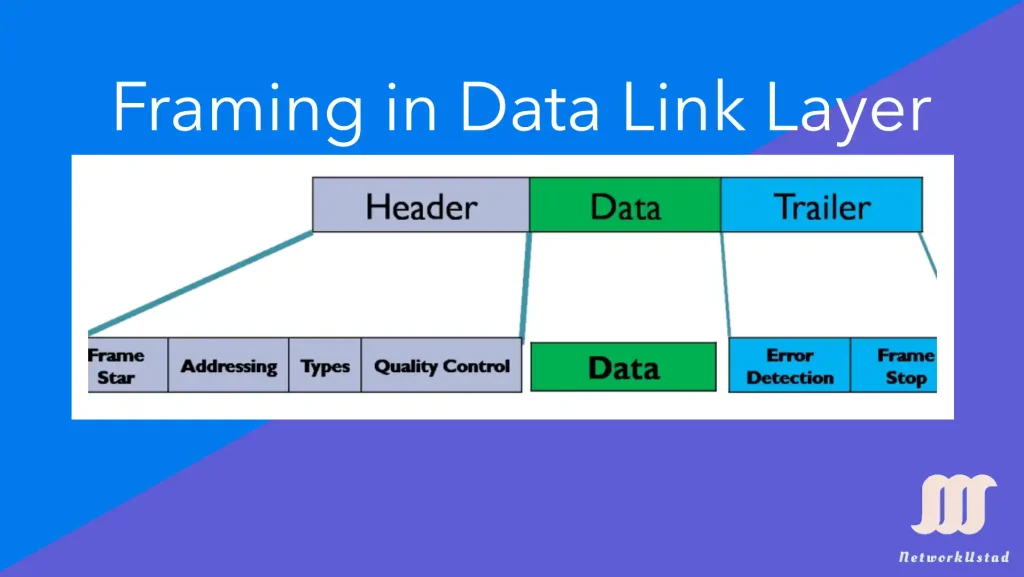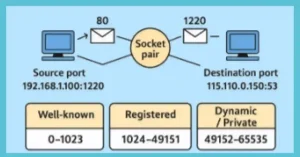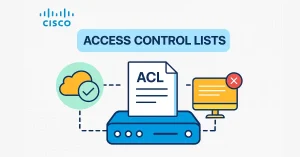Data-link layer framing is a critical process in networking, enabling reliable data transmission across diverse media. The data-link layer takes packets from the Network Layer and encapsulates them into frames, the fundamental data units for network communication. If the frame size becomes too large, the packet may be divided into smaller frames to ensure efficient flow and error control, especially in high-speed networks like Wi-Fi 6 and Ethernet 802.3.
Frames are transmitted between network points and contain complete addressing, protocol, and control information. Before transmission, the data-link layer protocol encapsulates the frame with a header and trailer, which are later de-encapsulated at the receiving end.
Frame Structure
Various data-link layer protocols define unique frame structures, such as Ethernet, Point-to-Point Protocol (PPP), and High-Level Data Link Control (HDLC). Each protocol tailors the frame’s header and trailer fields to meet specific media and topology requirements. For instance, PPP frames differ from HDLC frames in their control fields, reflecting their distinct use cases.
There are a lot of different data link layer protocols that describe data link layer frames. At the receiving end, again, data link layer protocols explain and de-encapsulate this frame. The figure below illustrates a frame which has three essential parts:-
- Header: Contains control and addressing information.
- Data: The payload, typically a Network Layer packet.
- Trailer: Includes error detection mechanisms.

The frame fields
The general frame is shown in the image mentioned above, but the structure of the frame, which contains fields in the header and trailer, varies according to the protocol. For example, if you examine the PPP fields, which are different from the HDLC fields, no framing structure meets the requirements of all data transportation across all media types.
Depending on the background, the size of control information in the data link layer framing varies to match the media’s access control requirements and logical topology. So, the frame has no standard size; it varies according to the media and environment.
Typical frame fields are also illustrated in the image below:-

The specific fields within the header and trailer vary by protocol. Below are typical frame fields:
- Start and Stop Indicator Fields: Mark the beginning and end of the frame for synchronization.
- Addressing Fields: Specify source and destination nodes (e.g., MAC addresses in Ethernet).
- Type: Identifies the Layer 3 protocol in the data field (e.g., IPv4, IPv6).
- Control: Supports special services like Quality of Service (QoS) or flow control.
- Data: The payload, carrying the Network Layer packet.
- Error Detection: Includes mechanisms like CRC (Cyclic Redundancy Check) to detect transmission errors.
Frame Fields Summary
| Field | Purpose |
|---|---|
| Start/Stop Indicators | Synchronize frame boundaries |
| Addressing | Identify source and destination nodes |
| Type | Specify Layer 3 protocol |
| Control | Enable QoS or flow control |
| Data | Carry Network Layer packet |
| Error Detection | Ensure data integrity via CRC or checksum |
Modern Framing Protocols (2025)
In 2025, data-link layer framing remains vital in advanced networking environments. Ethernet 802.3, handling 90% of data center traffic, uses frames ranging from 64 to 1518 bytes, with jumbo frames up to 9000 bytes for high-performance applications. In wireless networks, Wi-Fi 6 (802.11ax) and Wi-Fi 7 (802.11be) rely on framing to manage high-density IoT and 5 G-integrated environments. For example, Wi-Fi 6 frames incorporate enhanced QoS fields to prioritize latency-sensitive traffic, such as video streaming or autonomous vehicle communication.
Conclusion
Data-link layer framing is a cornerstone of reliable network communication, enabling efficient data transmission across diverse media like Ethernet and Wi-Fi. By encapsulating packets into frames with headers, data, and trailers, protocols such as Ethernet 802.3 and Wi-Fi 6/7 ensure synchronization, error detection, and flow control in modern networks. In 2025, framing remains critical for high-performance applications, from data centers to IoT and 5G ecosystems. Understanding and optimizing framing protocols enhances network efficiency, supporting the seamless connectivity demanded by today’s advanced technologies.
FAQs
What is framing in the data link layer?
Framing in the data link layer involves dividing data into manageable pieces, called frames, to ensure reliable transmission and error checking in network communication.
Why is framing important in the data link layer?
Framing helps organize data for transmission, enabling error detection and correction, synchronization, and efficient data flow between network devices.
What are the different types of frames in networking?
Common types of frames include Ethernet frames, Point-to-Point Protocol (PPP) frames, and High-Level Data Link Control (HDLC) frames.
How does frame synchronisation work in the data link layer?
Frame synchronization ensures that the sender and receiver are aligned, recognizing the start and end of each frame to maintain data integrity.
What role do data link layer protocols play in framing?
Data link layer protocols, such as Ethernet and PPP, define the rules for framing, ensuring consistent and reliable data transmission across networks.





